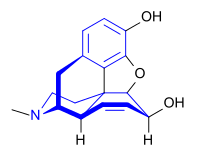
The term “twilight sleep” applied to the combination of analgesia (pain relief) and amnesia (loss of memory) that was produced by a mixture of morphine and scopolamine (“scope”) given by a hypodermic injection (an injection under the skin). The mixture of the two drugs created a state in which the woman, while responding somewhat to pain, did not remember it after delivering her baby. Twilight sleep was once in vogue in obstetrics.
Morphine and scopolamine are both venerable drugs that have been around a long time. Both are also naturally occurring members of the very large chemical class of compounds called alkaloids:
Morphine: The name “morphine” was coined in 1805 by the German pharmacist Adolf Serturner — “morphine” refers to Morpheus, the mythologic god of dreams — to designate the main alkaloid contained in opium. Opium, of course, comes from a plant: the poppy. Morphine is a powerful narcotic agent with strong analgesic action and other significant effects on the central nervous system. It is dangerously addicting. Scopolamine: Scopolamine was introduced in 1902 and used up until the 1960s. The name comes from that of the 18th-century Italian naturalist Giovanni Scopoli. Together with atropine, scopolamine is a component of belladonna which comes from a plant called “deadly nightshade,” once used as a means of poisoning ones enemy. When scopolamine is given in lower (non-poisonous) doses, it causes drowsiness, amnesia, and euphoria (a “high”) and was thus used as a preanesthetic agent. Combined with morphine, scopolamine provided childbirth without pain (or without the memory of pain), once a much sought-after objective. However, there were serious problems with twilight sleep. It completely removed the mother from the birth experience and it gravely depressed the baby’s central nervous system. This sometimes made for a drowsy depressed baby who was difficult to resusitate, to get breathing normally.
Twilight sleep has, therefore, fallen entirely out of favor and is now merely a chapter in the past history of obstetrics.
For more information visit: Melatrol website.

